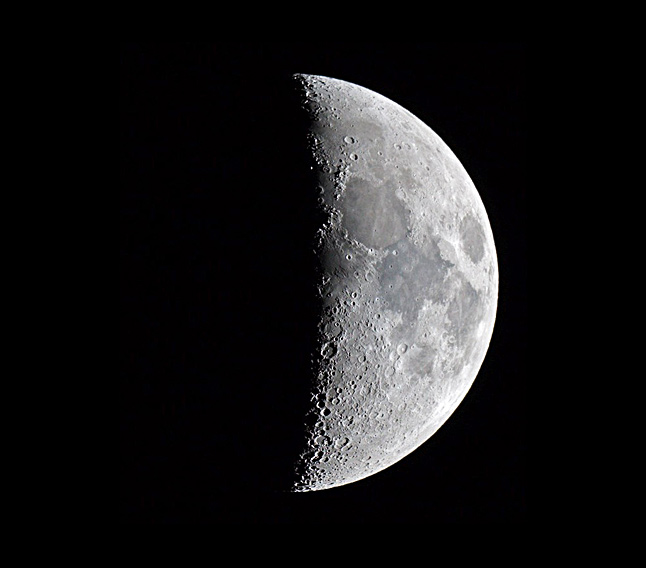
Gary Seronik
Maybe you just got a shiny new telescope to call your own. Congratulations — you could be on your way to making lifelong friends with stupendous, faraway things in the night sky over your roof.
However, most of them are so far and faint that just finding and positively identifying them is the challenge — and the accomplishment! Whether your new scope is a long, sleek tube or a compact marvel of computerized wizardry, surely you're itching to try it out.
Before You Observe
Here are three crucial tips for starting on the right foot, to avoid frustrations and move quickly up the learning curve.
First, get your scope all set up indoors. Read the instructions, and get to know how everything works — how the telescope moves, how to change eyepieces, and so on — in warmth and comfort. That way you won't have to figure out unfamiliar knobs, settings, and adjustments outside in the cold and dark.
Second, take the scope outside in the daytime and familiarize yourself with how it works on distant scenes — treetops, buildings — to get a good feel for what it actually does. Don't be surprised if the view is upside down; this keeps the optical parts nice and simple, and it doesn't matter because there's no up or down in space.
You'll quickly find that a telescope's lowest magnification (the eyepiece with the longest focal length, meaning the one with the highest number on it) gives the brightest, sharpest, and widest views, with the least amount of the wiggles. The lowest power also makes it easiest to find what you're trying to aim at, thanks to that relatively wide field of view. So you'll always want to start off with the lowest power. Switch to a higher-magnification eyepiece only after you've found your target, got it centered, and had a good, careful first look.
Also: If the telescope has a little finderscope or a red-dot pointing device attached to its side, daytime is the easiest time to align the finder with the main scope. You really need to do this. Aim the telescope at a distant treetop or other landmark, center it in the main view, lock the mount's motions if the mount allows this, recheck that the treetop is still centered, and then look through the finderscope. Use the finder's adjustment screws on the sides to center the crosshairs (or red dot) on the same treetop. Then recheck again that it's still in the center of the main scope's view, in case you may have bumped it off in the process.
Third, plan to be patient. Spend time with each sky object you're able to locate, and really get to know it. Too many first-time telescope users expect something like Hubble-like brightness and color in the eyepiece — when in fact most astronomical objects are very dim to the human eye. Moreover, our night vision sees dim things mostly as shades of gray. Much of what the universe has to offer is subtle and, again, extremely far away!
But the longer and more carefully you examine something, the more of it you'll gradually discern. Astronomy teaches patience.
On the other hand, the Moon and the naked-eye planets are bright and easy to find! They make excellent first targets for new telescopic observers. Sky & Telescope's This Week's Sky at a Glance has suggestions for both telescopic and naked-eye viewing of the brightest stars and planets.
Here are some suggestions for starting off.
New-Telescope Delight: The Moon
The Moon is one celestial object that never fails to impress in even the most humble scope. It’s our nearest neighbor in space — big, bright, starkly bleak, and just a quarter million miles away. That's a hundred times closer than the nearest planet ever gets. An amateur telescope and a detailed Moon map can keep you busy with it forever.
Tonight (December 25, 2022) a very thin crescent Moon shines low in the southwest in twilight. It's still too thin to show much of its surface, but take a look! And notice the earthshine dimly illuminating the Moon's big dark portion. That's the Moon's night landscape being lit by the nearly full Earth shining in the Moon's sky.
For the next few evenings the Moon will grow thicker and higher. By Wednesday the 28th it will be just about like the photo at the top of this page. After that it thickens through first quarter (half lit) into its "bulgy" gibbous phase, as the Sun rises on more and more of the side facing Earth.
The Moon will become full on January 8th. But when the Moon is full we see no shadows being cast sideways to dramatize the mountains and craters. You see lunar surface features best near the Moon's terminator, the lunar sunrise or sunset line. Look again at the photo at the top of this page. The terminator is where the low Sun in the lunar sky casts stark black shadows even from low hills, mountains, and crater walls.
The advancing terminator unveils new landscapes day by day when the Moon is waxing, then hides them in darkness day by day when the Moon is waning after full. In between at full Moon, the terminator lies all around the Moon's edge essentially out of sight.
Bright Planets
As it happens, your new scope has arrived when three bright, naked-eye planets adorn the evening sky. Saturn is low in the southwest right after dark, a steady yellowish point to the right of the twinklier star Fomalhaut. And the Moon is near Saturn tomorrow night the 26th.
Saturn is currently about as far from Earth as it gets, but even a modest scope at 50 or 100 power will show Saturn's iconic reality as a ball in rings. Catch it early before it gets too low.
Jupiter is that bright white point high in the south after dark, far to Saturn's upper left. Even the smallest telescope will show Jupiter's four pointlike moons lined up on either side of it. They change configuration endlessly from night to night. Tonight December 25th you'll find Callisto and Europa on one side of Jupiter, and Io and Ganymede closer to the planet on its other side.
Jupiter itself spins so fast (once every 10 hours) that it's not quite round, and a small telescope will reveal this. And can you make out any of Jupiter's parallel cloud belts? They often darken or brighten, broaden or narrow, over a matter of months or years. Jupiter too is somewhat farther from Earth right now than we usually see it. It'll be closest next fall.
The Moon poses near Jupiter on December 28th and 29th.
Mars is the brightest yellow-orange tinted "star" high in the east in early evening. The Moon gets over there to it on January 3rd. Mars is a small planet, half the diameter of Earth, and it appears pretty tiny in any telescope. You may or may not be able to detect any surface markings even with long, steady examination. But don't give up too soon. When you're working near the limit of your vision, as you usually will be in astronomy, it takes time and continued attention to see all that you can see. Things that were at first invisible may start to occasionally flicker into view, then become definite enough to hold almost steadily. Did we say astronomy teaches patience?
More New-Telescope Sights
There's much more to the night sky than the Moon and planets, of course! Winter nights often bring crisp, transparent skies with a grand canopy of stars. But with so many inviting targets overhead, where to point first?
Well, to the upper right of Mars, by less than the width of your fist at arm's length, there's the Pleiades star cluster. It's visible to the naked eye as a little patch about the size of your fingertip at arm's length. Most people can make out the six brightest Pleiades stars with no optical aid, but a telescope will show a whole swarm, and the dipper pattern will look huge and bright — even overspilling your eyepiece view at all but the very lowest magnification.
Astronomers have determined that the Pleiades cluster has more than 500 stars in all. Like other star clusters, the Pleiades are held together by their mutual gravity. This one is classed as an open cluster for the stars' relatively uncrowded arrangement. It's nearby as star clusters go, traveling through space as a swarm about 440 light-years away.
The Pleiades stars, astronomers have determined, began to shine only about 80 million years ago. This makes them mere toddlers compared to our Sun and solar system, which are 4.6 billion years old. M45’s youthful suns are astonishingly energetic. Alcyone (al-SIGH-oh-nee), the brightest, is at least 350 times as luminous as our Sun. Like the other bright Pleiads it gleams with an intense blue-white light — a sign that it’s unusually hot and massive.
Next, here's a deeper suggestion. The familiar constellation Orion climbs the southeastern sky in the evening at this time of year. In its middle, look for the three-star line of Orion's Belt. The Belt is almost vertical as it rises in early evening. It turns diagonal (as shown in below) later at night.
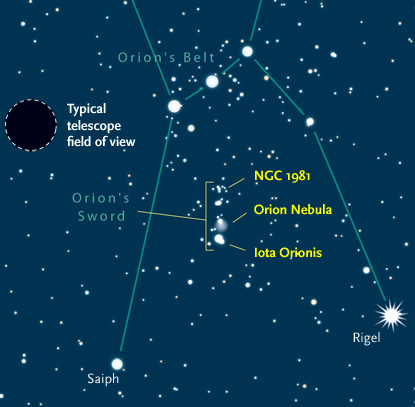
Sky & Telescope diagram
Just a few degrees south of the Belt (that is, a few finger-widths at arm's length) runs a smaller, dimmer line of stars: Orion's Sword. Within it lies the Orion Nebula, a luminous cloud of gas and dust where new stars are forming by the hundreds. It shows pink in many photographs, but to the human eye it's dim gray with a hint of green. The nebula is evident in any telescope once you get pointed at it, and so is the tight quartet of young stars near its center, known as the Trapezium. Astronomers refer to the Orion Nebula as Messier 42 (M42), and you'll see it labeled that way on star charts. Located about 1,400 light-years away, it's the closest massive star-forming nebula to Earth.
Dim objects like nebulae are best seen when the sky is moonless and really dark. The farther you can get out from under the skyglow of city light pollution, the better. But don't let light pollution dissuade you from finding what you can see from your own backyard! Choose reasonably bright targets to hunt, and develop the skills to find them and observe them carefully so you'll be ready to make the most of better conditions when the chance arises. For instance, the sky can be especially clean and dark the night after a storm passes through.
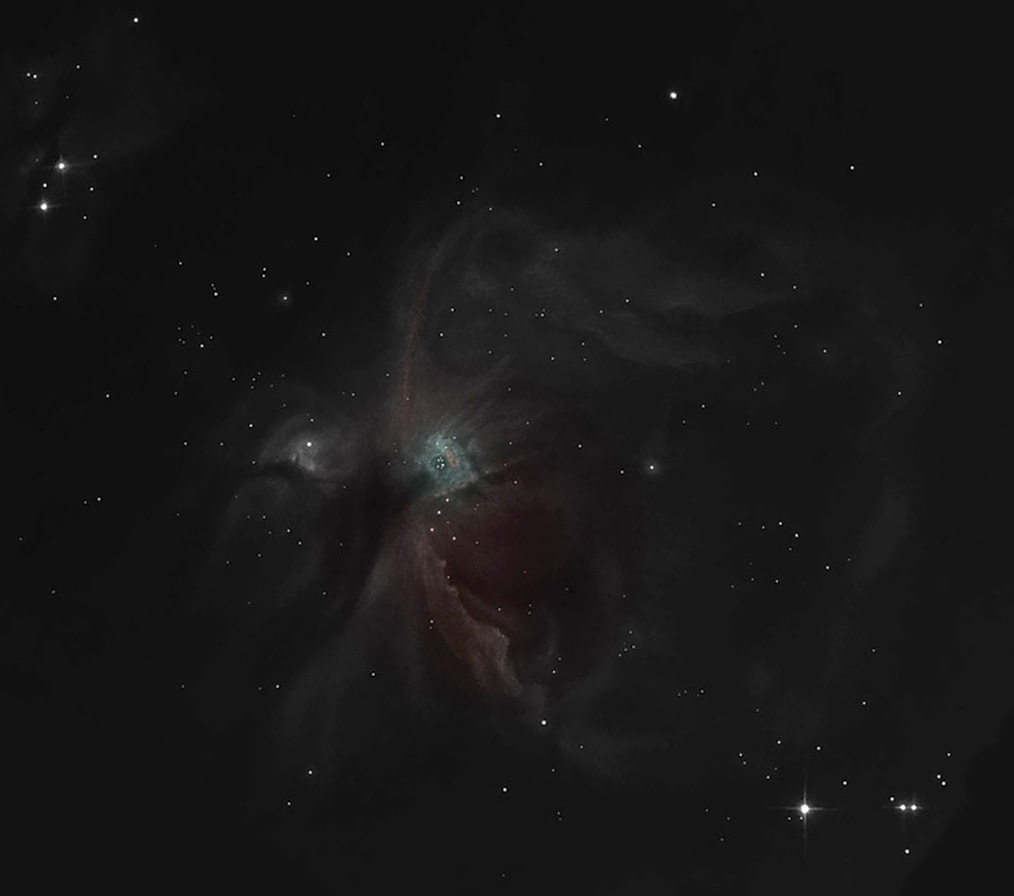
Howard Banich / S&T Online Gallery
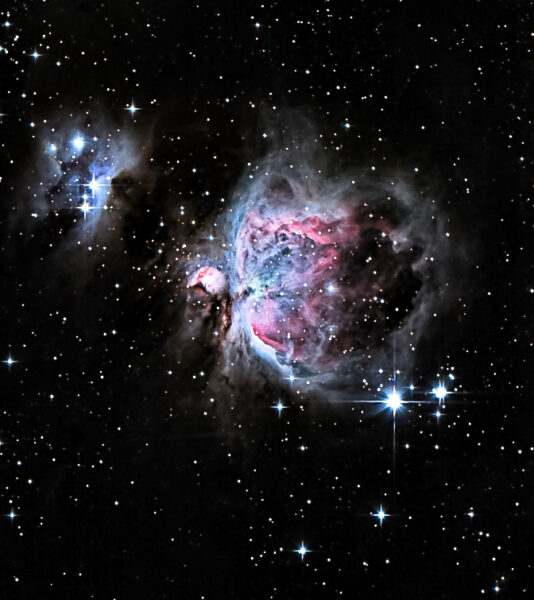
Joshua Rhoades / S&T Online Gallery
You can use Orion's Belt as a pointer to other things. Extend its line far upward across the sky, by about two fist-widths at arm's length, and there's the relatively bright star Aldebaran, the orange eye of Taurus. Continue on by about another fist and you'll reach the Pleiades.
Next Steps in Astronomy
To find much else in the night sky, start learning the constellations. They're the key to locating everything fainter and deeper to hunt with binoculars or a telescope — just like on a globe of Earth you need to know the continents and countries before you can pinpoint, say, Milan or Sydney or Jakarta.
For an easy-to-use constellation guide covering the whole evening sky, use the big monthly map in the center of each issue of Sky & Telescope, the essential magazine of astronomy (ahem).
You'll also want a good, detailed star atlas (set of more detailed maps), such as the widely used Pocket Sky Atlas; a good deep-sky guidebook; and some practice in how to use the maps to pinpoint the aim of your telescope onto something too faint to see with your eyes alone. Be sure to read our article How To Use a Star Chart with a Telescope.
For more tips on skywatching and how to get the most out of your scope, see our Observing section and Getting Started section.
Whatever else, stick with it! Nobody is born knowing this stuff. Work your way into the hobby at your own pace, finding things to know and do and understand without worrying about everything you don't yet. That's really what life in a big universe is all about, right?
 0
0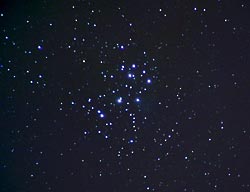

Comments
You must be logged in to post a comment.